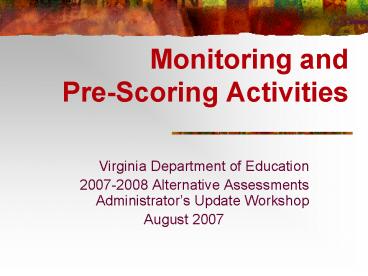Monitoring and PreScoring Activities PowerPoint PPT Presentation
1 / 29
Title: Monitoring and PreScoring Activities
1
Monitoring and Pre-Scoring Activities
- Virginia Department of Education
- 2007-2008 Alternative Assessments Administrators
Update Workshop - August 2007
2
Monitoring
- Periodic and systematic review of evidence-based
assessments in the development process with
opportunities for feedback and intervention.
3
What Monitoring is Not
- Checking with the teacher
- Flipping through an evidence based assessment
- Review without feedback
4
Pre-Scoring
- A detailed review of evidence-based assessments
against scoring rules prior to scoring with
opportunity for feedback and intervention
5
What Pre-Scoring is Not
- A mad dash to create a collection of evidence
6
Why Monitor and Pre-Score?
- To create better Collections of Evidence (COE)
and Coursework Compilations (CWC).
7
Why COEs and CWCs Fail
- Missing evidence to support the SOL
- Use of unacceptable evidence
- Use of evidence not aligned with the SOL
- Un-graded or incorrectly graded evidence
- Missing or incomplete SEI tags
8
Components of Monitoring
- Trained Reviewers
- Feedback Loops
- Intervention Options
9
Trained Reviewers
- Persons with Content Knowledge and V-Program
Knowledge - School Coordinator
- Assigned or Hired Staff
- Building Level Teams
- Central Office Level Teams
10
Feedback Loops
- Teachers preparing collections
- Principals
- V-Program Leaders
- Trainers/Technical Assistance
- Providers
11
Intervention Options
- Individualized Consultation and Support
- Peer or small group sessions
- Attendance at Local Training
- Access to state and local SOL or assessment
resources
12
Monitoring Decisions
- Who will monitor?
- How will you train them?
- When will monitoring occur?
- Who will receive feedback?
- How will feedback be given?
- What are your intervention options?
13
A Sample Monitoring Plan
- School-based Review Teams created and trained
- Teachers turn in evidence-based assessments every
nine-weeks - All evidence-based assessments reviewed by team
according to division pacing chart - Team report shared with principal and central
office - Central office dispatches Rapid Response Teams
14
A Sample Monitoring Plan
School-Based Teams Review COEs every 9 weeks
according to Pacing Chart and report To Principal
and Division V-Program Leaders
Select And Train School-Based Oversight Teams
Instructional Teams dispatched Based on 9 week
Report
15
A Sample School Review Team 9-Week Monitoring
Form
16
A Sample Teacher Review Form
- VGLA 9 Week Review Sheet
- School-Based Teams
- Teacher ____________________
- Student ___________________________ Grade
Level______ - Content Area_____________________________________
____ - REVIEW for ____ 1st Nine Weeks ____
3rd Nine Weeks - ____ 2nd Nine Weeks
____ 4th Nine Weeks - Reviewed By____________________________
Date________ - Collection Status Address the following
questions (1) Is there evidence for all of the
standards for the nine weeks according to the
Pacing Chart? (2) Does the work submitted align
with the standards satisfactorily? (2) Does the
evidence demonstrate student mastery? (3) Has the
student work been graded accurately? (4) Other? - Recommendation(s) Be as specific as possible
- Follow-up review needed for implementation of
recommendations - ___Yes ____No
- Follow up Review Date ________________
17
Pre-Scoring Activities
- Permits a review of the completed (or nearly
completed) collections of evidence and course
work compilations against scoring rules with
opportunity to make corrections
18
Rule 1- Evidence Must Show Individual Student
Achievement
- Does the evidence show any level of achievement
according to the SOL being defended? - Is the evidence on grade level?
- Are all the SOL addressed (stems and bullets)?
19
Rule 2- Evidence Must Be Student-Generated
- Has the evidence been copied from the blackboard,
textbook, or computer? - If the evidence is from a group project, is the
achievement of the V-Program participant clearly
identified? - If the evidence is a worksheet, are there
examples or directions that provide answers?
20
Rule 3 - Evidence Must Be Labeled with SEI Tags
- Does each piece of evidence have a completed SEI
tag with - Content area
- SOL
- Bullet (s)
- Demonstrated or Inferred checked
21
Rule 4- Evidence Must Address Accommodations,
Captions and Grading
- If accommodations have been used, are they
documented in the evidence? - Does each picture have a caption that clearly
address the students level of achievement? - Has the work been graded accurately with correct
and incorrect answers clearly identified?
22
Media Considerations
- Do videotapes and audiotapes have transcripts?
- Are videotapes and audiotapes clearly labeled
with SEI tags?
23
Organizational Considerations
- Is the evidence organized according to the
scoring worksheet? - Are all required state and local forms completed?
24
Pre-Scoring Decisions
- Who will pre-score?
- How will you train them?
- When will pre-scoring occur in relation to our
submission date? - Who will receive feedback?
- How will feedback be given?
- What are your intervention options?
25
Sample Pre-Scoring Plan
- PHASE 1 - Building Level Review
- Submitting Teacher Review
- School-Based Oversight Teams Review
- Building Administrator Review and sign-off
- PHASE 2 - Central Office Review
- Submitted from schools
- Reviewed by Central
- Office Teams
- Return to Schools to Correct identified errors or
omissions
26
VGLA Collection of Evidence Coversheet
27
Monitoring Pre-Scoring Results
- Reduces or Eliminates COEs and CWCs with
- Missing Evidence
- Unacceptable Evidence (textbooks, homework)
- Inaccurate or Ungraded Evidence
28
Monitoring Pre-Scoring Results
- Eliminates Surprises
- Collections not done for students educated
outside of the division - Incomplete collections in the division
- Collections not driven by IEP, 504 or LEP Student
Assessment Participation Plans
29
Questions
- Division of Student Assessment and School
Improvement - (804) 225-2107

